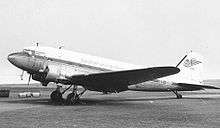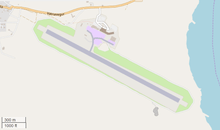Vágar Airport
| Vágar Airport Vága Floghavn | |||||||||||
|---|---|---|---|---|---|---|---|---|---|---|---|
|
| |||||||||||
| Summary | |||||||||||
| Airport type | Public | ||||||||||
| Operator | Civil Aviation Administration | ||||||||||
| Location | Sørvágur, Faroe Islands | ||||||||||
| Hub for | Atlantic Airways | ||||||||||
| Elevation AMSL | 280 ft / 85 m | ||||||||||
| Coordinates | 62°03′49″N 007°16′38″W / 62.06361°N 7.27722°WCoordinates: 62°03′49″N 007°16′38″W / 62.06361°N 7.27722°W | ||||||||||
| Website | floghavn.fo | ||||||||||
| Map | |||||||||||
 EKVG Location in the Faroe Islands | |||||||||||
| Runways | |||||||||||
| |||||||||||
| Statistics (2015 [1]) | |||||||||||
| |||||||||||
Vágar Airport (Faroese: Vága Floghavn) (IATA: FAE, ICAO: EKVG) is the only airport in the Faroe Islands, and is located 1 NM (1.9 km; 1.2 mi) east[2] of Sørvágur. Due to the Faroe Islands' status as a self-governing territory, the airport is not subject to the rules of the European Union. It is the main operating base for Faroese national airline Atlantic Airways and, for a brief period during 2006, was also the base for the low cost airline FaroeJet.
History


Early years
The airport was built by British Royal Engineers during World War II on the island of Vágar. The site was chosen mainly because it was hard to see from the surrounding waters and any potential German warship. The first aeroplane landed here in Autumn 1942. (See British occupation of the Faroe Islands in World War II). British engineers had similarly first built Reykjavík Airport in Iceland in 1940, then known as RAF Reykjavik, following the British Occupation of Iceland.
After the war, Vágar airfield was abandoned and left unused until 1963 when it was reopened as a civilian airport at the initiative of two Sørvágur residents, Hugo Fjørðoy and Lars Larsen. The two worked with the Icelandic airline Icelandair, which began the scheduled flights to Bergen, Copenhagen and Glasgow using a Douglas DC-3 aircraft. In 1964 a separate airline, Faroe Airways, operated flights, first using chartered aircraft but in 1965 they bought a DC-3 from the Swedish airline Linjeflyg.[3] The company ceased operating on 28 September 1967. In 1971, Icelandair was operating Boeing 727-100 jetliners into the airport with weekly nonstop service to Glasgow and Reykjavik.[4] In 1988, Atlantic Airways was flying British Aerospace BAe 146-200 jet service nonstop to Copenhagen.[5] Until 2004 Maersk Air also operated flights into the airport. Maersk Air flew Boeing 737-500 jetliners into the airport with service to Copenhagen.[6][7]
Development since the 2000s
Until 2002 travel from the airport to most locations in the Faroe Islands including the capital Tórshavn required a car ferry, but since the Vágatunnilin, a tolled road tunnel, was opened, travel has been made much easier by giving direct road access to the neighbouring island of Streymoy, where Tórshavn is located.
A new terminal opened 17 June 2014 with increased passenger capacity.[8]
The runway was extended from 1,250 m (4,100 ft) to 1,799 m (5,902 ft) in 2011, allowing a greater variety of aircraft types to be used, and further-away destinations to be introduced.[9] Construction work started in May 2010, and on 3 December 2011, the extended runway was opened and put into use for the first time.[10] Previously, jet aircraft with short airfield performance such as the British Aerospace BAe 146 (which ceased to be produced 2001) were preferred for use into the airport (although Maersk Air operated flights with Boeing 737-500 aircraft),[6] and then the most distant destination was Copenhagen, 1,300 km (810 mi). The Airbus A319 of Atlantic Airways is able to utilise the extended runway, and services with this type with Atlantic Airways began in March 2012.[11] Tourist summer flights to Barcelona and Milan were introduced. However, in 2014 they decided to stop the routes to Milan and to London. Instead, they chose to fly to Mallorca and to Aberdeen, later changed to Edinburgh.[12]
The airport is currently managed by the Danish Transport Authority although the ownership of the airport was handed over to the Faroese government in May 2007.[13][14]
A number of domestic Faroese destinations can be reached from Vágar by the Atlantic Airways helicopter service. International destinations include Copenhagen, Aalborg and Billund in Denmark, Reykjavík in Iceland, Edinburgh in the United Kingdom (Scotland), Bergen in Norway and Barcelona and Palma de Mallorca in Spain.
Airlines and destinations
The following airlines offer regular passenger scheduled and charter flights at Vágar Airport:
| Airlines | Destinations |
|---|---|
| Atlantic Airways | Bergen, Billund, Copenhagen, Reykjavík Seasonal: Aalborg, Barcelona, Chambéry, Chania, Edinburgh, Gran Canaria, Lisbon, Palma de Mallorca Charter: Kristiansund, Trondheim Seasonal charter: Alicante |
| Atlantic Airways Helicopter | Dímun, Froðba, Hattarvík, Kirkja, Klaksvík, Koltur, Mykines, Skúvoy, Svínoy, Tórshavn |
| Scandinavian Airlines | Copenhagen |
There are occasional public charter flights done by major European airlines, e.g. Wizzair and Austrian Airlines, for example for supporters to football qualification matches.[15][16] There are also fairly frequent corporate charter flights (seats not available to public) done by e.g. Widerøe.[17] The extended runway and better instrument landing system has made it easier for other airlines than Atlantic Airways to land at Vagar.
Ground transport
There are bus services about 10 times each direction per day between the airport and Tórshavn. They take one hour. The road distance to Tórshavn is 47 km (29 mi). The "Vágatunnilin" tunnel (4.9 km (3.0 mi)) connects the airport and the Vágar island to the main towns and villages in the Faroe Islands.
Accidents and incidents
- 3 August 1996: a Gulfstream III of the Danish Air Force crashed during final approach to Vágar Airport in bad weather and poor visibility. Nine people, including the Chief of Defence Jørgen Garde and his wife, perished as the aircraft collided with high terrain surrounding the airport.
- 25 January 1975: a Fokker F27 aircraft registered as OY-APB attempted to land on a wet and icy runway. Without having been informed of the conditions, the pilots veered the aircraft off the runway and collided with terrain.[18][19]
- 26 September 1970: Icelandair Fokker F27 originating in Copenhagen with a stopover in Bergen, Norway. The flight from Bergen to Vágar Airport crashed in bad weather on Mykines. Eight of the 34 passengers lost their lives, and the badly injured were airlifted away by helicopter. A marble memorial was placed in the Church.
See also
References
- ↑ "Ársfrásøgn 2013". Vága Floghavn. Retrieved 2014-06-18.
- 1 2 Faroe Islands AIP for EKVG – Vágar Airport from Naviair
- ↑ "Faroe Airways - Gyldendal - Den Store Danske".
- ↑ http://www.timetableimages.com, April 1, 1971 Icelandair system timetable
- ↑ http://www.timetableimages.com, May 30, 1988 Atlantic Airways system timetable
- 1 2 http://www.airliners.net, photo of Maersk Air Boeing 737-500 at Vagar Airport
- ↑ October 1993 Official Airline Guide (OAG) Worldwide edition, Faroe Islands flight schedules
- ↑ "News - FAE - Vága Floghavn". Archived from the original on 20 February 2015.
- ↑ "A 1.799 m. long runway and terminal for a total of DKK. 412". Oct 2009. Archived from the original on 24 September 2015.
- ↑ Celebrating the extended runway Archived 24 May 2012 at the Wayback Machine.
- ↑ Atlantic Airways A319 enters service Archived 19 April 2014 at the Wayback Machine., 28 March. 2012
- ↑ Atlantic.fo - Flúgv til Mallorca í summar 2015 Archived 20 January 2015 at the Wayback Machine.
- ↑ "L 210: Nedbringelse af fondens egenkapital til dækning af omkostninger til bortskaffelse af sprængstof ved Vágar Lufthavn".
- ↑ "Statens Luftfartsvæsen: Færøerne overtager Vagar Lufthavn". Archived from the original on 30 May 2012.
- ↑ Records being broken on the Faroe Islands
- ↑ Continued growth at Faroe Islands airport
- ↑ Næppe udsigt til konkurrence på Færøerne
- ↑ Ellemose: 57
- ↑ "Saturday 25 January 1975". Aviation Safety Network. Retrieved 21 September 2014.
External links
![]()